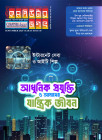হোম > National Data Center for Hosted Services
লেখক পরিচিতি
লেখকের নাম:
তারেক মাসুদুর বরকতুল্লাহ্
মোট লেখা:১২
লেখা সম্পর্কিত
পাবলিশ:
২০১০ - জুলাই
তথ্যসূত্র:
কমপিউটার জগৎ
লেখার ধরণ:
ডাটাবেজ
তথ্যসূত্র:
ইংরেজি সেকশন
ভাষা:
বাংলা
স্বত্ত্ব:
কমপিউটার জগৎ
National Data Center for Hosted Services
Presently the web infrastructure of respective ministries of the Government of Bangladesh is decentralized offering limited or no security. This has led to build a data center for hosted services involving intelligent thought, which reflects the philosophy of the design as well as the ease, flexibility, security and robustness of the network and be able to accommodate other latest technologies in the near future in its network with ease. A data center (or datacentre) is a facility used to house computer systems and associated components, such as telecommunications and storage systems. It generally includes redundant or backup power supplies, redundant data communications connections, environmental controls (e.g., air conditioning, fire suppression) and security devices. (source: http://en.wikipedia.org/wiki/Data_center ).

The national data center implementation includes the following components:
1. Design, Audit & Certification of Data Center
2. Construction of Data Center
3. Installation of Data Center infrastructure components (Routing & Switching equipment, Servers, SAN, Software components, etc.)
4. Configuration of Software as per requirement
5. Associated spare parts for mission critical components
6. Network management for 3 (three) years
7. Training
Design of the data center needs are perfectly coordinated and prescribed as per international standards. All necessary mission architecture have fully redundant package providing maximum robustness to the architecture. The system is flexible to cater any plug-in as and when required in terms of adding additional network architecture. Network Operations Center (NOC) being built along the data center will be a vital ingredient for the network. It will provide facility for network and application monitoring to prevent intrusion and hacking. An essential ingredient of this network is that it needs to be highly secured in order to cater the security level infrastructure needs of an international standard network. In the age of information where governments are often engaged by renegade groups / organizations in the cyber world, the web infrastructure meet the requirement of physically secured infrastructure with a strong network intrusion prevention solution. Under any circumstance, the site will serve information to the people mitigating any / all threats that may arise as a result of Internet based hacking attacks such as Denial of Service (DoS) and Spamming.

The National Data Center will meet international Data Center design standards, therefore the design and implementation of the Data Center will be certified from accredited organizations. Proper auditing of the Data Center is incorporated to ensure that Data Center meets international standard requirements. Globally, Data Centers are defined between Tier 1 to Tier 4 to measure the reliability of the data center infrastructure. This is useful in measuring:
a) Data center performance,
b) Investment,
c) ROI (return on investment)
A four tier system that provides a simple and effective means for identifying different data center site infrastructure design topologies. The Uptime Institute's tiered classification system is an industry standard approach to site infrastructure functionality addresses common benchmarking standard needs. The four tiers, as classified by The Uptime Institute include the following:
" Tier 1: composed of a single path for power and cooling distribution, without redundant components, providing 99.671% availability.
" Tier II: composed of a single path for power and cooling distribution, with redundant components, providing 99.741% availability
" Tier III: composed of multiple active power and cooling distribution paths, but only one path active, has redundant components, and is concurrently maintainable, providing 99.982% availability
" Tier IV: composed of multiple active power and cooling distribution paths, has redundant components, and is fault tolerant, providing 99.995% availability.
Tier 4 data center considered as most robust and less prone to failures. Tier 4 is designed to host mission critical servers and computer systems, with fully redundant subsystems (cooling, power, network links, storage etc) and compartmentalized security zones controlled by biometric access controls methods. Naturally, the simplest is a Tier 1 data center used by small business or shops.
" Tier 1 = Non-redundant capacity components (single uplink and servers).
" Tier 2 = Tier 1 + Redundant capacity components.
" Tier 3 = Tier 1 + Tier 2 + Dual-powered equipments and multiple uplinks.
" Tier 4 = Tier 1 + Tier 2 + Tier 3 + all components are fully fault-tolerant including uplinks, storage, chillers, HVAC systems, servers etc. Everything is dual-powered.
The necessity of certified Tier III/IV data centers in Bangladesh has become a necesity to meet the demand of Online Services by the government, public sectors and the private sectors in view of the envisioned Vision 2021: Digital Bangladesh. One of such facility will be available in Bangladesh for hosted services for the government by the end of this year. The national data center will not only provide hosting services but will also be able to host digital signature certification application through the Public Key Infrastructure (PKI) paving way for electronic transaction.
The demand for shared data center in Bangladesh will grow within few years as more and more organization will start adopting online business model. Private sector entrepreneurs are also keen to establish data centers to meet the needs. One such successful example is ColoCity Data Center established at 82, Mohakhali, Dhaka for hosted services. It has already attracted clients from financial and telecom sectors.
Bangladesh needs to build number of certified minimum tier 3 data centers for providing online services. Private sectors can establish such centers to carter the growing demand from the government and industry. The shared hosted data center service can be a new area for entrepreneurs to serve not only the needs of the local demand but also for the international enterprises.
CJ WEB
Feedback tbarkatullah@yahoo.com
লেখাটি পিডিএফ ফর্মেটে ডাউনলোড করুন
লেখাটির সহায়ক ভিডিও
পাঠকের মন্তব্য
অনুরূপ লেখা



